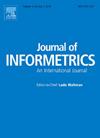通过三个固定的维度追踪图书馆和信息科学的演变:图书馆、人和算法
IF 3.5
2区 管理学
Q2 COMPUTER SCIENCE, INTERDISCIPLINARY APPLICATIONS
引用次数: 0
摘要
随着技术的快速进步和社会的变化,图书馆与信息科学(LIS)领域正在发生巨大的变化。为了捕捉这些变化,我们分析了1990年至2023年期间超过14万份LIS出版物,从三个语义维度考察了该学科的研究演变:图书馆,代表了LIS的历史基础和制度基础;人,代表核心互动参与者和LIS以人为本的焦点;和算法,代表了LIS中新兴技术驱动的方法进步。利用Doc2Vec和多标签联合训练方案,我们为各种LIS实体创建了一致的嵌入空间,包括研究术语、论文、期刊和国家。通过将这些实体映射到以三个锚定维度为基础的统一框架中,我们发现自20世纪90年代以来占主导地位的图书馆维度的出版物在2011年后有所下降,这反映在LIS研究、期刊集群和国家的重点转移上。与此同时,LIS研究也向人的维度倾斜,与人相关的研究演变为一个更加独立的分支。该算法维度正在迅速崛起,与该算法维度联系越紧密的期刊影响因子越高,期刊和国家的研究质心正在向该算法维度趋同。然而,以算法为主导的研究越来越脱离了其他两个维度,尤其是图书馆。此外,发达国家优先考虑与图书馆和人员维度相关的研究,而发展中国家则更强调以算法为重点的出版物。为了确保稳健性,我们使用最近针对LIS上下文进行微调的ModernBERT模型进一步验证了我们的结果。研究结果揭示了LIS内部的发展动态和潜在的碎片化,为学者、期刊、机构和政策制定者提供了见解。本文章由计算机程序翻译,如有差异,请以英文原文为准。
Tracing the evolution of library and information science through three anchored dimensions: Library, people, and algorithm
With rapid technological advancements and societal changes, the field of Library and Information Science (LIS) is dramatically evolving. To capture these shifts, we analyzed over 140,000 LIS publications ranging from 1990 to 2023, examining the discipline’s research evolution across three semantic dimensions: library, representing the historical foundation and institutional infrastructure of LIS; people, representing the core interacting participants and human-centered focus of LIS; and algorithm, representing the methodological advancements driven by emerging technologies in LIS. Utilizing Doc2Vec with a multi-label joint training scheme, we created a consistent embedding space for various LIS entities, including research terms, papers, journals, and countries. By mapping these entities onto a unified framework underpinned by three anchored dimensions, we reveal that the publications of the library dimension, dominant since the 1990s, have declined after 2011, reflected in the focus shifts of LIS research, journal clusters, and nations. Concurrently, LIS research has gravitated toward the people dimension, with people-related studies evolving into a more independent branch. The algorithm dimension is rapidly emerging, with journals more closely associated with it exhibiting higher impact factors, and the research centroids of journals and countries are converging toward it. However, algorithm-dominated research is increasingly detached from the other two dimensions, especially the library. Additionally, developed countries prioritize the research related to library and people dimensions, while developing countries exhibit a stronger emphasis on algorithms-focused publications. To ensure robustness, we further validated our results using a recent ModernBERT model fine-tuned for the LIS context. The findings reveal the developmental dynamics and potential fragmentation within LIS, offering insights for scholars, journals, institutions, and policymakers.
求助全文
通过发布文献求助,成功后即可免费获取论文全文。
去求助
来源期刊

Journal of Informetrics
Social Sciences-Library and Information Sciences
CiteScore
6.40
自引率
16.20%
发文量
95
期刊介绍:
Journal of Informetrics (JOI) publishes rigorous high-quality research on quantitative aspects of information science. The main focus of the journal is on topics in bibliometrics, scientometrics, webometrics, patentometrics, altmetrics and research evaluation. Contributions studying informetric problems using methods from other quantitative fields, such as mathematics, statistics, computer science, economics and econometrics, and network science, are especially encouraged. JOI publishes both theoretical and empirical work. In general, case studies, for instance a bibliometric analysis focusing on a specific research field or a specific country, are not considered suitable for publication in JOI, unless they contain innovative methodological elements.
 求助内容:
求助内容: 应助结果提醒方式:
应助结果提醒方式:


